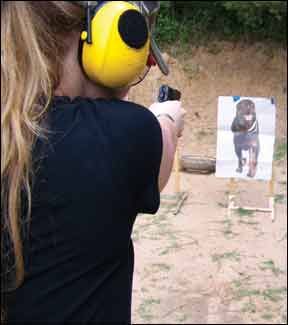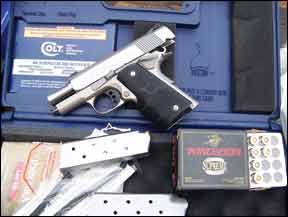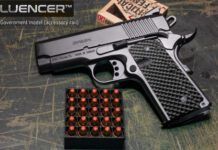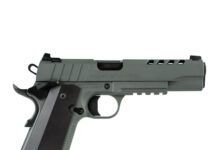There is something reassuring about a big-bore pistol in the pocket or on the belt in a holster. Professionals going in harms way appreciate the design and power of a big-bore autoloader. So do armed citizens. These handguns are not for everyone, but for the shooter willing to practice and learn to control their recoil, these guns represent unprecedented levels of protection ounce for ounce. Those who purchase a light 32 ACP, 380 ACP, or 9mm often fire a magazine or two and slip the pistol in their pocket. Those who purchase the 45-caliber compacts are often serious shooters who practice diligently. For this reason, the shortcomings of the type are recognized and any problems come to light quickly.

Big-bore handgunners demand reliability and a certain amount of accuracy from their choices. The most reliable are the compact handguns that had their origins in military designs. These include the Glock and the 1911. While considerable engineering was undertaken to modify the locking and unlocking sequence and spring technology is very important, in the end these handguns in all frame sizes rely upon the original design for much of their reliability and handling. The good features of the parent pistols, the Glock Model 21 and the Colt 1911, survive.
We began this shootout with the premise of firing the Glock 36, the archetypical slim-frame single-column-magazine Glock against the Colt Defender, Colts smallest 1911. The matchup was deemed a classic, pitting the greatest example of downsized technology from both the blue-steel-and-walnut camp and the polymer-frame camp. However, we added a third pistol almost at the last moment because the Springfield Micro is in line with the others, but in terms of price it competes with the Glock-the Defender is by far the most expensive of the three. The new owner of the Springfield Micro protested that while he wanted a good small 45, he could not take a beating, meaning he could not take a hit to his wallet. He owns several other Springfield pistols, including a TRP, three Loaded Models, a GI, a LW Operator and a Champion Super Tuned. He knows the difference in performance between GI sights and Novak sights, but he needed a compact carry gun and Springfield quality appealed to him. The addition of the Springfield gave us another interesting dimension in comparison. We now had three compact pistols with polymer, aluminum, and steel frames. We can only say the shootout was interesting, and even our most experienced raters could not call this one until the last shots were fired.
Glock 36 45 ACP, $550
The Glock features the archetypical polymer frame and safe-action trigger of the Glock series. This pistol is unique to Glock in that it features a single-column magazine holding six rounds. For those with smaller hand sizes, the Glock 36 is superior to the Glock 30, a double-column-magazine pistol that is otherwise similar. Although the six-round magazine of the 36 is smaller than the Glock 30, it is not as flat and slim as the 1911 six-round magazine. It is downright thick and requires a magazine carrier of some substance to carry the spare magazine. Trigger action of the 36 is typical Glock, 5.5 pounds to break with the usual rapid reset. The sights are the typical Glock plastic sights.
In test-firing the Glock, there was nothing unexpected. The owner took the pistol out of the box and it came up firing, never failing to feed, chamber, fire, or eject with any modern hollowpoint. There is a prohibition against using lead bullets in the Glock due to the polygonal rifling. There is simply no room for lead to build up as is the case with conventional lands and grooves construction. On the other hand, polygonal rifling often produces more velocity with a given round than a conventionally rifled barrel of similar length. The Glock produced more velocity by a margin than the other pistols tested, partly because of the longer barrel and probably somewhat due to the rifling used. The prohibition against lead limits versatility, but it is what it is.
A caution concerning the Glock is that the chamber of the Glock is largely unsupported. This means that +P loads should be used sparingly, and handloads with well-worked brass are not a wise idea. We are not likely to use +Ps in such light handguns. Just the same, case expansion was normal with the Glock and the Cor-Bon +P loads used.
Much of the appeal of the Glock is subjective. The pistol is modern, light, and reliable. It is simple to use. There is no manual safety.

Draw and fire. The utmost caution must be used when holstering the pistol. If you have your finger in the trigger guard and you snag on the holster-bang! Our primary rater, a man with great police experience, recommends that the Glock be carefully placed in the holster and then the holster strapped on for safety when it comes to deep-concealment holsters. The safeties of the Glock are all passive. The firing-pin block is a drop safety. It isnt always understood, but the tiny lever in the trigger is actually a drop safety as well. While the trigger is resistant to lateral pressure when the safety is not pressed, the trigger has enough momentum to move and fire the partially prepped Glock trigger action. The safety lever is a fail safe against trigger jump if the pistol is dropped.
In firing, handfit was not as great a concern as with the double-column magazine Glock pistols. Most raters found the pistol fit their hands well. The bore axis is relatively lower than with other types of Glock pistols. Felt recoil was another advantage. While control was not the greatest demonstrated, due to the grip design, as far as comfort this pistol was rated the most comfortable to fire. Felt recoil was subjectively less than even the much heavier Micro. Part of the reason is that the polymer frame gives a bit in recoil. You have to maintain a good grip to prevent short cycles, but just the same, we did not experience a short cycle at all with the Glock.
The only disconcerting results reported by shooters was the typical tingle in the trigger finger caused by feedback when the Glock is fired. Glock shooters ignore this feedback during recoil. Trigger reset was rapid with reset rivaling or equaling the rapid reset of the 1911 pistols. Overall, here is a defensive pistol with little lacking. The only criticism of the type is that there is no positive manual safety. Those who prefer this action type will not be dissuaded. The sights are middle of the road, good for combat shooting but far from ideal for accuracy. As for accuracy, the pistol gave good combat groups, but pinpoint accuracy was not in the cards. Still, the results are an acceptable standard for a compact pistol.
Our Team Said: The takedown and maintenance procedure of the Glock is by far the easiest to handle. The pistol breaks down in seconds, and it is not difficult to clean and reassemble the pistol. We carried the Glock concealed in a Don Hume IWB for a week or so, and while the holster is a good choice, the Glock was noticeably blockier than either of the 1911 handguns. The Glock represents the modern polymer frame-pistol well, but we believe that there are better choices in the marketplace.
Springfield Micro PW 45 ACP, $530
The Micro is a miniaturized GI pistol. While often advertised as a Micro GI Mil Spec, the 5-inch-barrel Mil Spec features better sights than the GI. This pistol has GI sights. Unlike the other two pistols, the Micro is supplied with a single magazine. We used Metalform six-round magazines during the test to supplement the single magazine supplied with the Micro. While many pistols of this size feature high-visibility sights, extended controls, and a beavertail safety, the Micro is strictly GI. For this reason the pistol retails at about the same price as the Glock, while other compact 1911 pistols such as the Defender are much more expensive. Our initial examination of the Micro showed the pistol is tight, very tight. We predicted that this 45 pistol would experience a few break-in short cycles, but we were mistaken. The Micro came out of the box running, an improvement over the traditional GI type pistol. The Micro uses the now-proven belled-barrel lockup that was developed to give the short-slide 1911 reliability. The standard barrel bushing does not allow sufficient barrel tilt in short-slide pistols. The Springfield also features standard-size (GI) controls, which were OK. They are not likely to snag when carrying the pistol concealed. An advantage of the Springfield is a ramped barrel. This ramped barrel eliminates many of the problems associated with feed reliability with both sharp-shouldered lead SWC bullets and jacketed hollowpoint bullets. The ramped barrel is also touted as an advantage with aluminum frames, preventing the blunt nose of JHP bullets from gouging the feed ramp. However, the Micro features a steel frame. We compared the specifications of the Micro against the Defender with the Defenders original Hogue grips in place. The Micro is slightly more compact in important dimensions. The trigger action is the heaviest of the three handguns at 6.5 pounds. It did not feel quite as heavy as the RCBS registering scale showed, but the scale does not lie.
There were no failures to feed, chamber, fire, or eject with any type of ammunition. When firing tests came, however, all was not roses. The Micro was rated more comfortable to fire than the Defender due to the greater weight of the pistol, however, this comfort was alloyed with the fact that you had to concentrate to fully depress the grip safety or the pistol would not fire. This is true of many 1911 handguns, but the geometry of most modern 1911 handguns allows the majority of shooters with most hand sizes to capably handle the type. Shooters using the popular thumbs-forward grip must realize that this grip lifts the palm off of the grip safety pad. The Defender grip safety is enlarged to a degree, and you can get away with the thumbs-up grip style. The Micro demands a true “lemon squeezer” grip. We have said this before-a shooter adopting a compact 1911 really needs to begin with a full-size 1911 and master the type before moving to the compact 1911. The grip-safety problem is exactly the reason grip safeties were originally modified into the beavertail type.
We appreciate the grip safety and all of the implication of an additional safety, but master your control of the grip safety. This problem did not occur with the Defender. The owner of the Micro, one of our raters, noted that he was in it for the long haul and would simply adapt to the pistol as he would have with any GI pistol. All of the raters took this advice to heart and adopted a strong grip that pressed the palm against the grip safety. As for sight regulation, the Springfield was well regulated horizontally for the 230-grain ball loads used for practice at 7 and 10 yards. For windage, the pistol was off a good 3 inches to the left, which we easily fixed with a brass punch and mallet courtesy of the W. R. Grace gunsmiths kit. GI sights are small but precise when properly lined up. We would like to see a true Mil Spec version of this pistol with larger sights, but the GI sights are what we had here.
They presented a struggled for 25-yard accuracy. Although the raters used Hansen Eagle Eye shooting glasses as an aid when firing groups at long range, the GI sights were a limiting factor, and so was the heavy trigger action. In the end, the Micro did not challenge the Defender or the Glock for accuracy. Also, although the pistol is the heaviest tested, the advantage in comfort over the Defender was slight, doubtless because of the superior grip safety design of the Defender. Only after firing 50 rounds or so did the increased recoil of Defender become noticeable, causing sore wrists. The less experienced the shooter, the more recoil is noticed.
Our Team Said: The takedown of the Springfield was not as friendly as the full-size 1911, but the dual recoil spring is a welcome addition to a compact pistol. The Springfield is the flattest and shortest of the tested pistols. At close range the three all did well as far as slow-fire accuracy, but the poor sights of the Springfield Micro began to tell on it at ranges past 10 yards. The Micro was supplied with one magazine; the others were supplied with two. However, the Micro was supplied with a plastic range holster and magazine carrier.
Colt Defender 07000D 45 ACP, $910
Colts Defender owes much of its success to refinements from consulting Cylinder & Slide Shop, Incorporated, a respected custom shop. The 3-inch-belled barrel, high-visibility sights, full-length guide rod, and efficient beavertail safety are all custom additions. Trigger compression was rated the best of the group, with average compression running at 4.5 pounds and very clean. The pistol never failed to feed, chamber, fire, or eject. Reliability was never a question. The Hogue rubber grips supplied with the pistol were not popular. Finger-groove grips tend to stretch an average-size hand in firing drills. We shot the pistol as supplied initially, but then changed the grips out for a set of Ahrends custom Tactical grips and reevaluated. The Ahrends grips were at least as comfortable as the Hogues, but gave a much better feel. (Ahrends Tactical Grips list for $50 to $60 at www.Brownells.com).
When firing the pistol, the beavertail grip safety made for comfort and greater speed into action as the hand is funneled into the grip. As might be expected, recoil was the most noticeable of the three pistols tested, as the Defender weighs a mere 22 ounces. The effect was startling to the uninitiated raters. One, used to the Glock 26 9mm, has never fired a big-bore pistol. The good handfit and low bore axis certainly helps, but this is not the pistol for a beginner. Just the same, we cannot think of a means of making the pistol easier to control. The laws of physics are immutable. Either get a heavier gun or a lighter load. Interestingly, if you did not lock the wrists, the pistols action slowed and you could actually feel the slide working, and the difference was noticeable as the heavy spring rocked the slide back. Of course we lock our wrists when we fire a handgun. Function was much more positive with the standard grip and locked wrist. Still, this is a pistol with plenty of recoil, and some shooters relaxed the grip as recoil told on their shooting ability. As mentioned before, it was not a sharp pain to experienced shooters, but the effect was cumulative. The sights were rated the best of the group, and the pistol was easily the most accurate tested, with a singular 2-inch 25-yard group capable of a service pistol. However, most of the groups were larger, and it takes a seasoned shooter to get the best from this pistol. Even experienced shooters tire from taking a death grip after firing a number of groups.
Our Team Said: The Defender is the lightest and thinnest, making it easiest to carry and conceal, although the Springfield is very slightly shorter, but taller if you figure in the lanyard ring attached to the Springfield. Most felt that the grip shape made the Defender the fastest into action. It is the most accurate, but difficult to control unless you have time in with the type. The Colts sights are first class.
It comes down to this: if you cannot tolerate cocked-and-locked carry, the Glock is for you. If you cannot tolerate a pistol without a manual safety, the Springfield or Colt are good choices. After careful consideration, and rating all of the comfort ratings and the accuracy tests as well, as well as flatness and concealability, the Colt Defender is the winner in the judgment of our staff. Some may feel that the advantages of the Defender, including its good sights, do not outweigh the nearly double price disadvantage of the Colt. But the Colt outshot the Glock and the problems-admitably shooter related-experienced in managing the grip safety of the Springfield bump it into a long third place. You are forewarned on the grips-if you like them, great. Would we still buy this gun ahead of the Glock 36? Yes, narrowly. With replacement grips, we give the gun our highest mark.
0711-GLOCK-MODEL-36-45-ACP.pdf
0711-SPRINGFIELD-MICRO-COMPACT.pdf




























